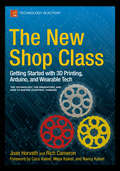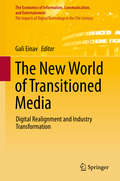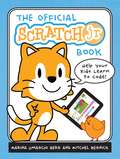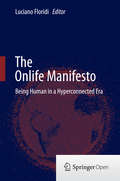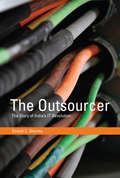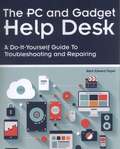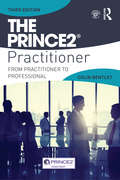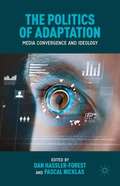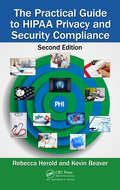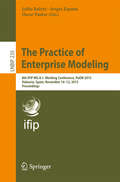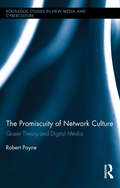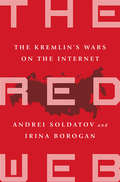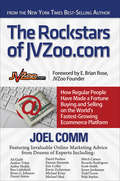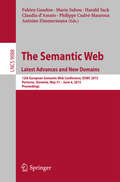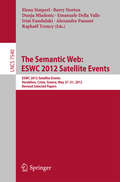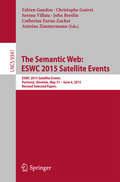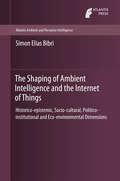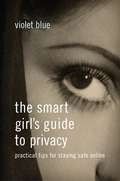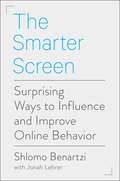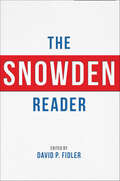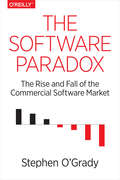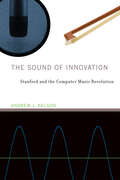- Table View
- List View
The New Shop Class
by Joan Horvath Rich CameronThe New Shop Class connects the worlds of the maker and hacker with that of the scientist and engineer. If you are a parent or educator or a budding maker yourself, and you feel overwhelmed with all of the possible technologies, this book will get you started with clear discussions of what open source technologies like 3D printers, Arduinos, robots and wearable tech can really do in the right hands. Written by real "rocket scientist" Joan Horvath, author of Mastering 3D Printing, and 3D printing expert Rich Cameron (AKA whosawhatsis), The New Shop Class is a friendly, down-to-earth chat about how hands-on making things can lead to a science career. Get practical suggestions about how to use technologies like 3D printing, Arduino, and simple electronics Learn how to stay a step ahead of the young makers in your life and how to encourage them in maker activities Discover how engineers and scientists got their start, and how their mindsets mirror that of the maker What you'll learn What all of the big "maker" technologies are, what they can do, and how to get more information Why scientists, citizen scientists, and makers do what they do -- and how they do what they do Why breaking things is as important as making things How portrayals of science differ from the real world How to encourage the young scientists and makers in your life, or become one yourself What scientists and makers can learn from each other Who this book is for Aspiring scientists, makers, teachers, students, and anyone who wants a guide to the vast and expanding world of makers and their tools and inventions. Table of Contents Front Matter: Featuring a Foreword by Coco Kaleel, Mosa Kaleel, and Nancy Kaleel Part 1. The Technologies Chapter 1. 21st Century Shop Teacher Chapter 2. Arduino, Raspberry Pi, and Programming Physical Things Chapter 3. 3D Printing Chapter 4. Robots, Drones, and Other Things that Move Part 2. Applications and Communities Chapter 5. Makerspaces and Hackerspaces Chapter 6. Citizen Science and Open Source Labs Chapter 7. Cosplay, Wearable Tech and the Internet of Things Chapter 8. Circuits and Programming for Kids Chapter 9. Open Source Mindset and Community Chapter 10. Creating Female Makers Chapter 11. Making at a Community College and Beyond Part 3. How Scientists Get Started Chapter 12. Becoming a Scientist Chapter 13. How Do Scientists Think? Chapter 14. What Do Scientists Do All Day? Part 4. Tying It All Together Chapter 15. Learning by Iterating Chapter 16. Learning Science by Making Chapter 17. What Scientists Can Learn from Makers Appendix: Links
The New World of Transitioned Media
by Gali EinavThe media industry is undergoing an accelerated pace of change, driven in large part by the proliferation of digital platforms. In many cases, the speed of adoption has exceeded our ability to process the impact of these changes on individuals and society at large. This book provides a "behind-the-scenes" look at the media industry's transition into the digital era and examines its impact on marketing, advertising, innovation and other economic and social activities. The impact of digital technologies on traditional media sectors, such as advertising, video games, film and television is well-documented. Less understood is its effect on our perceptions, thought processes and inter-personal relationships. Social media, for example, represents a fundamental change in the ways we interact with media, communicate with each other and even present ourselves to the world. This has shaped the way we communicate with institutions and brands. Similar to the first "Transitioned Media" book, Transitioned Media: A Turning Point into the Digital Realm, this book combines media industry leaders and academics to explore various transformative trends and issues. Themes include measuring cross-platform behaviour, artificial intelligence in journalism, the evolution of video games, digital media and physical space, the mobile use trends, social media and the corporate world, the changes in the television and newspaper business and the evolving relationship between advertisers and target audiences. The varied backgrounds of contributors and array of topics make for a unique and insightful point of view.
The New York City Police Department: The Impact of Its Policies and Practices
by John A. EternoStudying the flagship New York City Police Department is critical to understanding policing and democratic society. An examination of the department by experts who have been studying it for years, The New York City Police Department: The Impact of Its Policies and Practices provides a frank and open discussion about the NYPD from an elite group of scholars with varying viewpoints and concerns. The authors in this book are uniquely qualified to discuss and analyze the intricacies of policies and their impact.
The Official Candy Crush Saga Top Tips Guide
by Candy CrushThe FIRST OFFICIAL gamers' guide from the team behind CANDY CRUSH SAGA. For anyone that has ever jumped for joy after clearing that tricky level, battled the bothersome Chocolate, or done a happy-dance when they created a Color Bomb; this is the guide for you.This comprehensive insiders guide offers readers an in-depth insight into the Candy Kingdom and Dreamworld, including mastering the mechanics of the game, plus exclusive tips and strategies for clearing the most challenging levels. It's Delicious!
The Official Scratch Jr. Book: Help Your Kids Learn to Code
by Mitchel Resnick Marina Umaschi BersScratchJr is a free, introductory computer programming language that runs on iPads, Android tablets, Amazon tablets, and Chromebooks. Inspired by Scratch, the wildly popular programming language used by millions of children worldwide, ScratchJr helps even younger kids create their own playful animations, interactive stories, and dynamic games.The Official ScratchJr Book is the perfect companion to this free app and makes coding easy and fun for all. Kids learn to program by connecting blocks of code to make characters move, jump, dance, and sing.Each chapter includes several activities that build on one another, culminating in a fun final project. These hands-on activities help kids develop computational-thinking, problem-solving, and design skills. In each activity, you’ll find:–Step-by-step, easy-to-follow directions–Ways to connect the activity with literacy and math concepts–Tips for grown-ups and teachers–Creative challenges to take the learning furtherBy the end of the book, kids will be ready for all sorts of new programming adventures!The ScratchJr app now supports English, Spanish, Catalan, Dutch, French, Italian, and Thai.
The Onlife Manifesto
by Luciano FloridiWhat is the impact of information and communication technologies (ICTs) on the human condition? In order to address this question, in 2012 the European Commission organized a research project entitled The Onlife Initiative: concept reengineering for rethinking societal concerns in the digital transition. This volume collects the work of the Onlife Initiative. It explores how the development and widespread use of ICTs have a radical impact on the human condition. ICTs are not mere tools but rather social forces that are increasingly affecting our self-conception (who we are), our mutual interactions (how we socialise); our conception of reality (our metaphysics); and our interactions with reality (our agency). In each case, ICTs have a huge ethical, legal, and political significance, yet one with which we have begun to come to terms only recently. The impact exercised by ICTs is due to at least four major transformations: the blurring of the distinction between reality and virtuality; the blurring of the distinction between human, machine and nature; the reversal from information scarcity to information abundance; and the shift from the primacy of stand-alone things, properties, and binary relations, to the primacy of interactions, processes and networks. Such transformations are testing the foundations of our conceptual frameworks. Our current conceptual toolbox is no longer fitted to address new ICT-related challenges. This is not only a problem in itself. It is also a risk, because the lack of a clear understanding of our present time may easily lead to negative projections about the future. The goal of The Manifesto, and of the whole book that contextualises, is therefore that of contributing to the update of our philosophy. It is a constructive goal. The book is meant to be a positive contribution to rethinking the philosophy on which policies are built in a hyperconnected world, so that we may have a better chance of understanding our ICT-related problems and solving them satisfactorily. The Manifesto launches an open debate on the impacts of ICTs on public spaces, politics and societal expectations toward policymaking in the Digital Agenda for Europe's remit. More broadly, it helps start a reflection on the way in which a hyperconnected world calls for rethinking the referential frameworks on which policies are built.
The Outsourcer: The Story of India's IT Revolution (History of Computing)
by Dinesh C. SharmaA history of how India became a major player in the global technology industry, mapping technological, economic, and political transformations. The rise of the Indian information technology industry is a remarkable economic success story. Software and services exports from India amounted to less than $100 million in 1990, and today come close to $100 billion. But, as Dinesh Sharma explains in The Outsourcer, Indian IT's success has a long prehistory; it did not begin with software support, or with American firms' eager recruitment of cheap and plentiful programming labor, or with India's economic liberalization of the 1990s. The foundations of India's IT revolution were laid long ago, even before the country's independence from British rule in 1947, as leading Indian scientists established research institutes that became centers for the development of computer science and technology. The “miracle” of Indian IT is actually a story about the long work of converting skills and knowledge into capital and wealth. With The Outsourcer, Sharma offers the first comprehensive history of the forces that drove India's IT success.Sharma describes India's early development of computer technology, part of the country's efforts to achieve national self-sufficiency, and shows that excessive state control stifled IT industry growth before economic policy changed in 1991. He traces the rise and fall (and return) of IBM in India and the emergence of pioneering indigenous hardware and software firms. He describes the satellite communication links and state-sponsored, tax-free technology parks that made software-related outsourcing by foreign firms viable, and the tsunami of outsourcing operations at the beginning of the new millennium. It is the convergence of many factors, from the tradition of technical education to the rise of entrepreneurship to advances in communication technology, that have made the spectacular growth of India's IT industry possible.
The PC And Gadget Help Desk: A Do-it-yourself Guide To Troubleshooting And Repairing
by Mark SoperWe all use technology—and we all have problems with it. Don’t get frustrated… and don’t waste money on costly repair or support calls! Solve the problems yourself, with the one guide that makes it easy: The PC and Gadget Help Desk. Using clear pictures, handy “symptom tables,” and easy-to-use flowcharts, Mark Edward Soper walks you step-by-step through identifying, solving, and preventing hundreds of today’s most aggravating tech problems. Soper covers all your major platforms: iPhones, iPads, Android devices, Windows systems, and more. He even helps you fix the weird problems that happen when you use them together!
The PRINCE2 Practitioner: From Practitioner to Professional
by Colin BentleyStruggling to apply the principles of PRINCE2 in practice? Need guidance on adapting the process for smaller projects? PRINCE2 for Practitioners provides the solution. This practical reference, matching the details and requirements of the 2009 PRINCE2 manual, contains new and updated real-life examples and case studies, links between related components and processes, and clear guidance on how to fine-tune the method to help you manage projects successfully, whatever the context and size. An affordable alternative to expensive training, this best-selling handbook by PRINCE2 expert Colin Bentley is an indispensable addition to your project management bookshelf and a companion to the PRINCE2 for Beginners book. If you have passed the PRINCE2 exams, it will help you keep your knowledge and skills up to date to maintain registered status and enable you to apply the theory of PRINCE2 to everyday project work after certification.
The Play of Political Culture, Emotion and Identity (Studies in the Psychosocial)
by Candida YatesOffering a uniquely 'psycho-cultural' take on the emotional dynamics of UK political culture this book uses theories and research in psychoanalysis, cultural and media studies and political sociology. It explores the cultural and emotional processes that shape our relationship to politics in a media age, referencing Joanna Lumley to Nigel Farage.
The Politics of Adaptation
by Dan Hassler-Forest Pascal NicklasIn the 21st century, the parallel movements of media convergence and globalization have reshaped our understanding of media boundaries. The rise of digital culture has increased our access to narrative media, while also providing new ways of engaging with them. But, at the same time, global media corporations have intensified their power over these media and the channels through which they reach us. This book brings together a broad range of scholarly approaches to the challenges and opportunities of adaptation studies in this new era. Together, they focus on the political and ideological tensions that underlie and shape processes of adaptation and cultural transformation in the age of media convergence.
The Practical Guide to HIPAA Privacy and Security Compliance
by Kevin Beaver Rebecca HeroldFollowing in the footsteps of its bestselling predecessor, The Practical Guide to HIPAA Privacy and Security Compliance, Second Edition is a one-stop, up-to-date resource on Health Insurance Portability and Accountability Act (HIPAA) privacy and security, including details on the HITECH Act, the 2013 Omnibus Rule, and the pending rules. Updated and
The Practice of Enterprise Modeling
by Jolita Ralyté Sergio España Óscar PastorThis volume constitutes the proceedings of the 8th IFIP WG 8. 1 Conference on the Practice of Enterprise Modeling held in November 2015 in Valencia, Spain. The PoEM conference series started in 2008 and aims to provide a forum sharing knowledge and experiences between the academic community and practitioners from industry and the public sector. The 23 short papers accepted were carefully reviewed and selected from 72 submissions and are organized in eight sections on Evolving Enterprises, Securing Enterprises, Making Empirical Studies, Investigating Enterprise Methods, Acquiring User Information, Managing Risks and Threats, Engineering Methods, and Making Decisions in Enterprises.
The Promiscuity of Network Culture: Queer Theory and Digital Media (Routledge Studies in New Media and Cyberculture)
by Robert PayneLiking, sharing, friending, going viral: what would it mean to recognize these current modes of media interaction as promiscuous? In a contemporary network culture characterized by a proliferation of new forms of intimate mediated sociality, this book argues that promiscuity is a new standard of user engagement. Intimate relations among media users and between users and their media are increasingly structured by an entrepreneurial logic and put to work for the economic interests of media corporations. But these multiple intimacies can also be understood as technologies of promiscuous desire serving both to liberalize mediated social connection and to contain it within normative frames of value. Payne brings crucial questions of gender, sexuality, intimacy, and attention back into conversation with recent thinking on network culture and social media, identifying the queer undercurrents of these current media dynamics.
The Red Web: The Struggle Between Russia's Digital Dictators and the New Online Revolutionaries
by Andrei Soldatov Irina BoroganHalf of Russia’s email traffic passes through an ordinary-looking building in an otherwise residential district of South West Moscow. On the eighth floor, in here a room occupied by the FSB, the successor organization to the KGB, is a box the size of a VHS player, marked SORM. SORM once intercepted just phone calls. Now it monitors emails, internet usage, Skype, and all social networks. It is the world’s most intrusive listening device, and it is the Russian Government’s front line for the battle of the future of the internet. Drawn from scores of interviews personally conducted with numerous prominent officials in in the ministry of communications and web-savvy activists challenging the state, Andrei Soldatov and Irina Borogan’s fearless investigative reporting in The Red Web is both harrowing and alarming. They explain the long and storied history of Russian advanced surveillance systems, from research laboratories in Soviet era labor camps to the legalization of government monitoring of all telephone and internet communications in 1995. But for every hacker subcontracted by the FSB to interfere with Russia’s antagonists abroad—such as those who in a massive Denial of Service attack overwhelmed the entire internet in neighboring Estonia—there is a radical or an opportunist who is using the web to chip away at the power of the state at home. Empowered by communication enabled by social media, a community of activists, editors, programmers and others are finding ways to challenge abusive state powers online. Alexei Navalny used his LiveJournal to expose political corruption in Russian, and gained a viral following after attacking Putin’s “party of crooks and thieves. ” Grigory Melkonyants, deputy director of the nation’s only independent election watchdog organization, developed a visual that tracked and mapped voter fraud across the country. And on December 10th, 2011 50,000 people crowded Bolotnaya Square to protest United Russia and its lawless practices. Twenty-four-year-old Ilya Klishin had used Facebook to spark the largest organized demonstration in Moscow since the dying days of the Soviet Union. The internet in Russia is either the most efficient totalitarian tool or the very device by which totalitarianism will be overthrown. Perhaps both. The Red Web exposes how easily a free global exchange can be splintered coerced into becoming a tool of geopolitical warfare. Without much-needed activism or regulation, the Internet will no longer be a safe and egalitarian public forum—but instead a site Balkanized and policed to suit the interests and agendas of the world’s most hostile governments.
The Rockstars of JVZoo.com: How Regular People Have Made a Fortune Buying and Selling on the World's Fastest Growing Ecommerce Platform
by Joel CommWhat Does it Take to Be an Online RockstarJVZoo is an amazing resource for entrepreneurs to turn their knowledge into digital products and recruit hundreds or thousands in their field to promote those products. Whether you are a business consultant, lawyer, real estate agent, or even someone who knows how to build the perfect birdhouse, JVZoo allows you to put your knowledge into a format that can be sold and profited from. While the rest of the world looks for jobs, JVZoo’s members create their own.In the three years that JVZoo has been around, it’s members have generated over $100 million in sales revenue. Our members are mainly people who started making money online as a part-time venture.Rockstars of JVZoo is a compilation of case studies, written by people just like you, people who listened to their inner voices and created jobs for themselves. Everything you are about to read in this book has been achieved by ordinary people who did that one thing that separates entrepreneurs from the rest of society: they took action.
The Semantic Web. Latest Advances and New Domains
by Harald Sack Fabien Gandon Antoine Zimmermann Claudia D'Amato Marta Sabou Philippe Cudré-MaurouxThis book constitutes the refereed proceedings of the 12th Extended Semantic Web Conference, ESWC 2014, held in Anissaras, Portoroz, Slovenia, in May/June 2015. The 43 revised full papers presented together with three invited talks were carefully reviewed and selected from 164 submissions. This program was completed by a demonstration and poster session, in which researchers had the chance to present their latest results and advances in the form of live demos. In addition, the PhD Symposium program included 12 contributions, selected out of 16 submissions. The core tracks of the research conference were complemented with new tracks focusing on linking machine and human computation at web scale (cognition and Semantic Web, Human Computation and Crowdsourcing) beside the following subjects Vocabularies, Schemas, Ontologies, Reasoning, Linked Data, Semantic Web and Web Science, Semantic Data Management, Big data, Scalability, Natural Language Processing and Information Retrieval, Machine Learning, Mobile Web, Internet of Things and Semantic Streams, Services, Web APIs and the Web of Things, Cognition and Semantic Web, Human Computation and Crowdsourcing and In-Use Industrial Track as well.
The Semantic Web: ESWC 2012 Satellite Events
by Emanuele Della Valle Elena Simperl Barry Norton Dunja Mladenic Irini Fundulaki Alexandre Passant Raphaël TroncyThis book constitutes the thoroughly refereed post-proceedings of the satellite events of the 9th International Conference on the Semantic Web, ESWC 2012, held in Heraklion, Crete, Greece, in May 2012. This volume contains 49 full papers and 13 short papers describing the posters and demonstrations. (SUGGESTION/ HELP needed).
The Semantic Web: ESWC 2015 Satellite Events, Portorož, Slovenia, May 31 – June 4, 2015, Revised Selected Papers (Lecture Notes in Computer Science #9341)
by Fabien Gandon Antoine Zimmermann Christophe Guéret Serena Villata John Breslin Catherine Faron-ZuckerThis book constitutes the thoroughly refereed post-conference proceedings of the Satellite Events of the 12th European Conference on the Semantic Web, ESWC 2015, held in Portorǒz, Slovenia, in May/June 2015. The volume contains 12 poster and 22 demonstration papers, selected from 50 submissions, as well as 22 best workshop papers selected from 140 papers presented at the 16 workshops that took place at ESWC 2015. The papers cover various aspects of the semantic web.
The Shaping of Ambient Intelligence and the Internet of Things
by Simon Elias BibriRecent advances in ICT have given rise to new socially disruptive technologies: AmI and the IoT, marking a major technological change which may lead to a drastic transformation of the technological ecosystem in all its complexity, as well as to a major alteration in technology use and thus daily living. Yet no work has systematically explored AmI and the IoT as advances in science and technology (S&T) and sociotechnical visions in light of their nature, underpinning, and practices along with their implications for individual and social wellbeing and for environmental health. AmI and the IoT raise new sets of questions: In what way can we conceptualize such technologies? How can we evaluate their benefits and risks? How should science-based technology and society's politics relate? Are science-based technology and society converging in new ways? It is with such questions that this book is concerned. Positioned within the research field of Science and Technology Studies (STS), which encourages analyses whose approaches are drawn from a variety of disciplinary perspectives, this book amalgamates an investigation of AmI and the IoT technologies based on a unique approach to cross-disciplinary integration; their ethical, social, cultural, political, and environmental effects; and a philosophical analysis and evaluation of the implications of such effects. An interdisciplinary approach is indeed necessary to understand the complex issue of scientific and technological innovations that S&T are not the only driving forces of the modern, high-tech society, as well as to respond holistically, knowledgeably, reflectively, and critically to the most pressing issues and significant challenges of the modern world. This book is the first systematic study on how AmI and the IoT applications of scientific discovery link up with other developments in the spheres of the European society, including culture, politics, policy, ethics and ecological philosophy. It situates AmI and the IoT developments and innovations as modernist science-based technology enterprises in a volatile and tense relationship with an inherently contingent, heterogeneous, fractured, conflictual, plural, and reflexive postmodern social world. The issue's topicality results in a book of interest to a wide readership in science, industry, politics, and policymaking, as well as of recommendation to anyone interested in learning the sociology, philosophy, and history of AmI and the IoT technologies, or to those who would like to better understand some of the ethical, environmental, social, cultural, and political dilemmas to what has been labeled the technologies of the 21st century.
The Smart Girl's Guide to Privacy: Practical Tips for Staying Safe Online
by Violet BlueThe whirlwind of social media, online dating, and mobile apps can make life a dream—or a nightmare. For every trustworthy website, there are countless jerks, bullies, and scam artists who want to harvest your personal information for their own purposes. But you can fight back, right now.In The Smart Girl’s Guide to Privacy, award-winning author and investigative journalist Violet Blue shows you how women are targeted online and how to keep yourself safe. Blue’s practical, user-friendly advice will teach you how to:–Delete personal content from websites–Use website and browser privacy controls effectively–Recover from and prevent identity theft–Figure out where the law protects you—and where it doesn’t–Set up safe online profiles–Remove yourself from people-finder websitesEven if your privacy has already been compromised, don’t panic. It’s not too late to take control. Let The Smart Girl’s Guide to Privacy help you cut through the confusion and start protecting your online life.
The Smarter Screen
by Jonah Lehrer Shlomo BenartziA leading behavioral economist shows how businesses can improve consumer thinking and decision-making on screens.The typical American office worker now spends the majority of his or her waking hours staring at a screen. In the 21st century, every business is a digital business, which is why it's so critical to understand how we think and behave online.Acclaimed behavioral economist Shlomo Benartzi reveals a toolkit of interventions for the digital age. Using provocative case-studies and engaging reader exercises, Benartzi shows how businesses can update their nudges to help consumers make better decisions on screens.Consider these solutions:The tournament model used for Wimbledon and March Madness may help consumers identify what they want more easily. While most websites attempt to display as many options as possible, if people can select options from manageable rounds they tend to make better choices.People are more willing to tell a gadget the truth about their risky health behaviors than an actual doctor. When dealing with sensitive subjects, the absence of human feedback - an absence made easy in an age of screens and machines - can be a great advantage.The precise location of an option on a screen can have a massive impact on consumer choice. (In some instances, screen location matters more than personal preference.) The same logic also applies to information, as certain layouts can dramatically influence our levels of attention.Although most websites are designed to make the act of reading as easy as possible, Benartzi explains why this can be a big mistake. Sometimes, the careful use of ugly fonts and other forms of "visual disfluency" are an important way to boost reading comprehension and retention.This book will help you transform the challenges of the digital world into powerful new opportunities that will drive your success in an age of screens.
The Snowden Reader
by David P. FidlerWhen Edward Snowden began leaking NSA documents in June 2013, his actions sparked impassioned debates about electronic surveillance, national security, and privacy in the digital age. The Snowden Reader looks at Snowden's disclosures and their aftermath. Critical analyses by experts discuss the historical, political, legal, and ethical issues raised by the disclosures. Over forty key documents related to the case are included, with introductory notes explaining their significance: documents leaked by Snowden; responses from the NSA, the Obama administration, and Congress; statements by foreign leaders, their governments, and international organizations; judicial rulings; findings of review committees; and Snowden's own statements. This book provides a valuable introduction and overview for anyone who wants to go beyond the headlines to understand this historic episode.
The Software Paradox: The Rise and Fall of the Commercial Software Market
by Stephen O'GradySoftware is more important than ever today and yet its commercial value is steadily declining. Microsoft, for instance, has seen its gross margins decrease for a decade, while startups and corporations alike are distributing free software that would have been worth millions a few years ago.Welcome to the software paradox. In this O’Reilly report, RedMonk’s Stephen O’Grady explains why the real money no longer lies in software, and what it means for companies that depend on that revenue. You’ll learn how this paradox came about and what your company can do in response.This book covers:Why it’s growing more difficult to sell software on a standalone basisHow software has come full circle, from enabler to product and back againThe roles that open source, software-as-a-service, and subscriptions playHow software developers have become the new kingmakersWhy Microsoft, Apple, and Google epitomize this transitionHow the paradox has affected other tech giants, such as Oracle and Salesforce.comStrategies your software firm can explore, including alternative revenue models
The Sound of Innovation: Stanford and the Computer Music Revolution (Inside Technology)
by Andrew J. NelsonHow a team of musicians, engineers, computer scientists, and psychologists developed computer music as an academic field and ushered in the era of digital music.In the 1960s, a team of Stanford musicians, engineers, computer scientists, and psychologists used computing in an entirely novel way: to produce and manipulate sound and create the sonic basis of new musical compositions. This group of interdisciplinary researchers at the nascent Center for Computer Research in Music and Acoustics (CCRMA, pronounced “karma”) helped to develop computer music as an academic field, invent the technologies that underlie it, and usher in the age of digital music. In The Sound of Innovation, Andrew Nelson chronicles the history of CCRMA, tracing its origins in Stanford's Artificial Intelligence Laboratory through its present-day influence on Silicon Valley and digital music groups worldwide. Nelson emphasizes CCRMA's interdisciplinarity, which stimulates creativity at the intersections of fields; its commitment to open sharing and users; and its pioneering commercial engagement. He shows that Stanford's outsized influence on the emergence of digital music came from the intertwining of these three modes, which brought together diverse supporters with different aims around a field of shared interest. Nelson thus challenges long-standing assumptions about the divisions between art and science, between the humanities and technology, and between academic research and commercial applications, showing how the story of a small group of musicians reveals substantial insights about innovation. Nelson draws on extensive archival research and dozens of interviews with digital music pioneers; the book's website provides access to original historic documents and other material.
